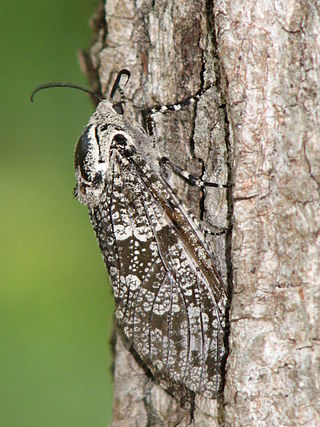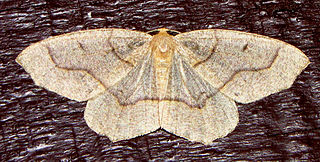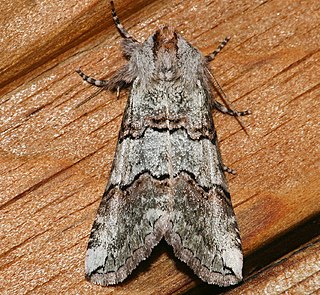
Moths are a group of insects that includes all members of the order Lepidoptera that are not butterflies. They were previously classified as suborder Heterocera, but the group is paraphyletic with respect to butterflies and neither subordinate taxon is used in modern classifications. Moths make up the vast majority of the order. There are approximately 160,000 species of moth, many of which have yet to be described. Most species of moth are nocturnal, although there are also crepuscular and diurnal species.

Alliaria petiolata, or garlic mustard, is a biennial flowering plant in the mustard family (Brassicaceae). It is native to Europe, western and central Asia, north-western Africa, Morocco, Iberia and the British Isles, north to northern Scandinavia, and east to northern Pakistan and Xinjiang in western China.

No. 24 Squadron (also known as No. XXIV Squadron) of the Royal Air Force is the Air Mobility Operational Conversion Unit (AM OCU). Based at RAF Brize Norton in Oxfordshire, 24 Squadron is responsible for aircrew training on A400M Atlas and C17 Globemaster. The squadron also delivers or oversees engineer training for these aircraft.

Benjamin Leroy Holt was an American businessman and inventor who patented and manufactured the first practical crawler-type tread tractor. The continuous-type track is used for heavy agricultural and engineering vehicles to spread the weight over a large area to prevent the vehicle from sinking into soft ground. He founded with his brothers the Holt Manufacturing Company.

William Penn "Pop" Gates was an American professional basketball player.
Richard Thomas Baker was an Australian economic botanist, museum curator and educator.

Abagrotis is a genus of moths of the family Noctuidae.

Prionoxystus robiniae, the carpenterworm moth or locust borer, is a moth of the family Cossidae. It was first described by Peck in 1818 and it is found in southern Canada and most of the United States.

Lambdina fiscellaria, the mournful thorn or hemlock looper, is a moth of the family Geometridae. It is found in North America, from the Pacific to the Atlantic coast and from Canada south to Pennsylvania, Wisconsin and California.
Ceranemota albertae, the Alberta lutestring, is a species of moth of the family Drepanidae first described by John Frederick Gates Clarke in 1938. It is found in western Canada, from south-central British Columbia east to south-eastern Saskatchewan. The habitat consists of dry open woodlands and shrub areas with wild cherry.

The gypsy moth, also known as the spongy moth, was introduced in 1868 into the United States by Étienne Léopold Trouvelot, a French scientist living in Medford, Massachusetts. Because native silk-spinning caterpillars were susceptible to disease, Trouvelot imported the species in order to breed a more resistant hybrid species. Some of the moths escaped, found suitable habitat, and began breeding. The gypsy moth is now a major pest of hardwood trees in the Eastern United States.

Lymantria dispar dispar, commonly known as the gypsy moth, European gypsy moth, LDD moth, or North American gypsy moth or spongy moth, is a species of moth in the family Erebidae. It has a native range that extends over Europe and parts of Africa, and is an invasive species in North America.

Orthosia hibisci, the speckled green fruitworm moth, is a moth of the family Noctuidae. It is found in most of North America, except in desert regions. The habitat consists of moist forests, riparian, agricultural and urban areas.

Ceranemota is a genus of moths belonging to the subfamily Thyatirinae of the Drepanidae.

Ceranemota improvisa is a moth in the family Drepanidae. It was described by Henry Edwards in 1873. It is found in North America, where it has been recorded from northern California, western Oregon, western Washington and south-western British Columbia. Adults are on wing from late September to November in one generation per year.

Ceranemota fasciata is a moth in the family Drepanidae. It was described by William Barnes and James Halliday McDunnough in 1910. It is found in North America, where it has been recorded from British Columbia to northern California. It is also present in coastal southern Alaska. The habitat consists of coastal rainforests, mixed hardwood forests and montane riparian areas.
Ceranemota semifasciata is a moth in the family Drepanidae. It was described by Foster Hendrickson Benjamin in 1938. It is found in North America, where it has been recorded from northern California.

Ceranemota tearlei is a moth in the family Drepanidae. It was described by Henry Edwards in 1888. It is found in North America, where it has been recorded from British Columbia and central Alberta south to central California in the west and to Utah and Colorado in the Rocky Mountains. The hindwings are lighter grey with somewhat darker markings. Adults are on wing from late August to October in one generation per year.
Ceranemota partida is a moth in the family Drepanidae. It was described by John Frederick Gates Clarke in 1938. It is found in North America, where it has been recorded from northern Colorado.














